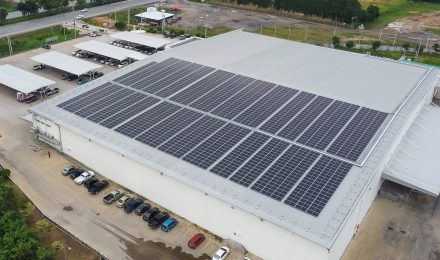Now, more than ever, consumers are taking power into their own hands. Many Americans are bridging the gap between sites of power generation by producing their own power for consumption through renewable energy sources. The increasing awareness and accessibility of renewable energy is empowering individuals and communities to embrace the role of “prosumer.”

Solar panels on top of the roof of an industrial facility. More businesses and even homeowners are adding solar panels to their property.
Prosumers not only consume but also produce energy, often through renewable resources such as solar and wind. This shift toward a more decentralized model of power generation, where energy is both consumed and contributed back to the grid, places new demands on – and highlights the critical importance of – robust transmission structures.
Crucial to this shift is the ability of energy transmission systems to adapt to the needs of prosumers. Wabash Valley Power Alliance (WVPA) is connecting local solar panel installations, and at times remote wind farms, to the larger energy grid. This ensures that energy can be efficiently delivered to where it’s needed, and that surplus energy is seamlessly carried to where it is needed. This two-way energy flow is vital in a landscape increasingly dominated by renewable sources, making every household and business a potential energy hub.
Advancements are consistently being made in energy storage, particularly in battery technology, allowing this prosumer model to become more viable than ever.
WVPA is at the forefront of these changes. This requires a constant focus on improving transmission capabilities to better integrate renewable sources and support the growing community of prosumers. By interconnecting with other grids, WVPA enhances reliability, mitigates potential grid challenges, and contributes to price stabilization, all crucial factors that will benefit all of the members of the electric distribution cooperatives we serve.
Improving our transmission infrastructure is not just a matter of energy efficiency; it’s a catalyst for economic growth and paves the way for job creation and community development. Cooperative members also benefit from the cost efficiencies associated with streamlined electricity delivery. As energy travels more efficiently, waste diminishes, leading to savings for everyone.
Yet, enhancing transmission capabilities is not without challenges. We must navigate land rights, shoulder the financial burden of investment, and overcome regulatory hurdles. Beyond that, technological obstacles demand innovation, calling for advancements that can meet the evolving needs of the energy landscape. WVPA is committed to innovation and technological advancements, ensuring that the transmission system keeps pace with the evolving needs of an increasingly complex energy landscape.

